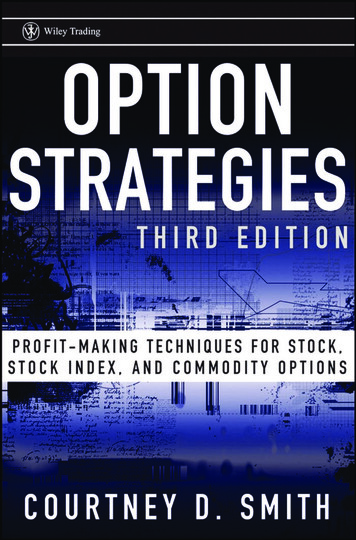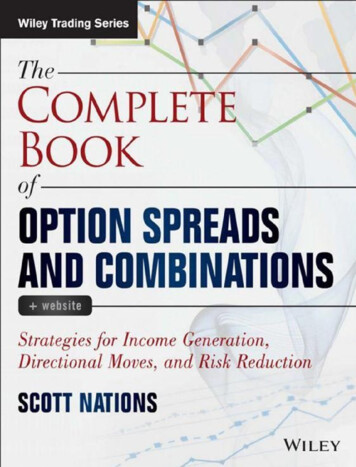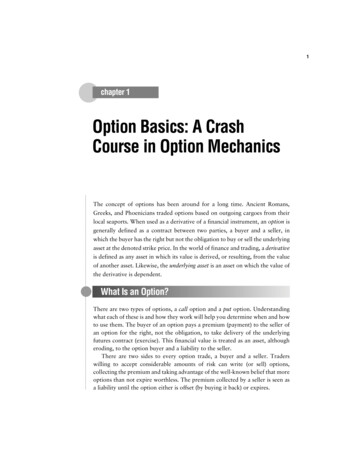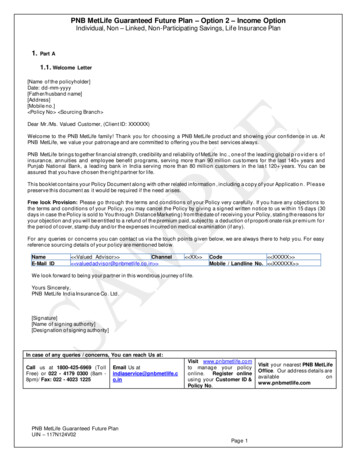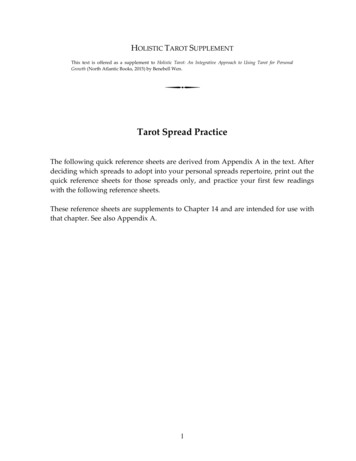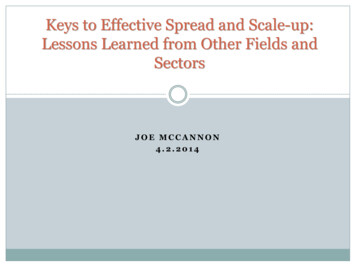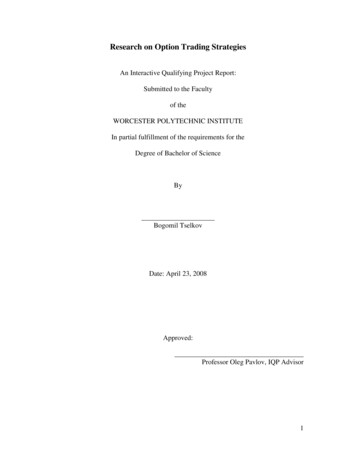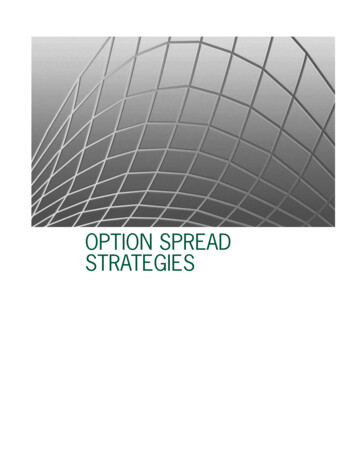
Transcription
OPTION SPREADSTRATEGIES
Also byANTHONY J. SALIBAwith Joseph C. Corona and Karen E. JohnsonOption Strategies for Directionless Markets:Trading with Butterflies, Iron Butterflies, and CondorsRelated titles also available from Bloomberg PressBLOOMBERG MARKET ESSENTIALS: TECHNICAL ANALYSISFibonacci Analysisby Constance BrownDeMark Indicatorsby Jason PerlBreakthroughs in Technical Analysis:New Thinking from the World’s Top Mindsedited by David KellerNew Insights on Covered Call Writing:The Powerful Technique That Enhances Returnand Lowers Risk in Stock Investingby Richard Lehman and Lawrence G. McMillanNew Thinking in Technical Analysis:Trading Models from the Mastersedited by Rick BensignorTrading ETFs:Gaining an Edge with Technical Analysisby Deron WagnerTrading Option Greeks:How Timing, Volatility, and Other Pricing Factors Drive Profitby Dan PassarelliA complete list of our titles is available atwww.bloomberg.com/booksATTENTION CORPORATIONSThis book is available for bulk purchase at special discounts. Specialeditions or chapter reprints can also be customized to specifications.For information, please e-mail Bloomberg Press, press@bloomberg.com,Attention: Director of Special Markets or phone 212-617-7966.
OPTION SPREADSTRATEGIESTrading Up, Down,and Sideways MarketsANTHONY J.SALIBABLOOMBERG PRESSNEW YORKwith Joseph C. Coronaand Karen E. Johnson
2009 by International Trading Institute, Ltd. All rights reserved. Protected under the BerneConvention. Printed in Canada. No part of this book may be reproduced, stored in a retrievalsystem, or transmitted, in any form or by any means, electronic, mechanical, photocopying,recording, or otherwise, without the prior written permission of the publisher except in the case ofbrief quotations embodied in critical articles and reviews. For information, please write: PermissionsDepartment, Bloomberg Press, 731 Lexington Avenue, New York, NY 10022 or send an e-mail topress@bloomberg.com.BLOOMBERG, BLOOMBERG ANYWHERE, BLOOMBERG.COM, BLOOMBERG MARKETESSENTIALS, Bloomberg Markets, BLOOMBERG NEWS, BLOOMBERG PRESS, BLOOMBERGPROFESSIONAL, BLOOMBERG RADIO, BLOOMBERG TELEVISION, and BLOOMBERGTRADEBOOK are trademarks and service marks of Bloomberg Finance L.P. (“BFLP”), a Delawarelimited partnership, or its subsidiaries. The BLOOMBERG PROFESSIONAL service (the “BPS”)is owned and distributed locally by BFLP and its subsidiaries in all jurisdictions other thanArgentina, Bermuda, China, India, Japan, and Korea (the “BLP Countries”). BFLP is a whollyowned subsidiary of Bloomberg L.P. (“BLP”). BLP provides BFLP with all global marketing andoperational support and service for these products and distributes the BPS either directly orthrough a non-BFLP subsidiary in the BLP Countries. All rights reserved.This publication contains the authors’ opinions and is designed to provide accurate and authoritativeinformation. It is sold with the understanding that the authors, publisher, and Bloomberg L.P. arenot engaged in rendering legal, accounting, investment-planning, or other professional advice. Thereader should seek the services of a qualified professional for such advice; the authors, publisher, andBloomberg L.P. cannot be held responsible for any loss incurred as a result of specific investments orplanning decisions made by the reader.First edition published 20091 3 5 7 9 10 8 6 4 2Library of Congress Cataloging-in-Publication DataSaliba, Anthony J.Option spread strategies : trading up, down, and sideways markets / Anthony J. Saliba with JosephC. Corona and Karen E. Johnson. — 1st ed.p. cm.Includes index.Summary: “Proven author Anthony Saliba provides step-by-step instructions for spread tradingtechniques for options traders. Saliba helps readers understand the nuances of each technique, when toemploy each spread strategy, and how to adjust when market conditions change. This hands-on guideincludes quizzes and a final exam to help readers test their comprehension”—Provided by publisher.ISBN 978-1-57660-260-7 (alk. paper)1. Stock options. 2. Options (Finance) I. Corona, Joseph C., 1957- II. Johnson, Karen E., 1967- III. Title.HG6042.S245 2009332.64'53—dc222008040986
Important DisclosuresFollowing are several important disclosures we are required to makeaccording to the rules of the Chicago Board Options Exchange (CBOE), bywhich we are governed. We encourage you to read them. Prior to buying or selling an option, one must receive a copy of thebooklet “Characteristics and Risks of Standardized Options.” Copies of this document are available at www.theocc.com/publications/risks/riskchap1.jsp or from International Trading Institute, Ltd., 311South Wacker Dr., Suite 4700, Chicago, IL 60606. Options involve risk and are not suitable for all investors. In order to trade strategies discussed in this book, an individual mustfirst have his account approved by a broker/dealer for that specifictrading level. No statement in this book should be construed as a recommendationto purchase or sell a security or as an attempt to provide investmentadvice. Writers of uncovered calls or puts will be obligated to meet applicable margin requirements for certain option strategies discussed inthis book. For transactions that involve buying and writing multiple options incombination, it may be impossible at times to simultaneously executetransactions in all of the options involved in the combination. There is increased risk exposure when you exercise or close out ofone side of a combination while the other side of the trade remainsoutstanding. Because all option transactions have important tax considerations,you should consult a tax adviser as to how taxes will affect the outcome of contemplated options transactions. The examples in this book do not include commissions and other costs.Transaction costs may be significant, especially in option strategies
viImportant Disclosurescalling for multiple purchases and sales of options, such as spreadsand straddles. Most spread transactions must be done in a margin account. Supporting documentation for any claims and statistical informationis available upon request by contacting International Trading Institute, Ltd., 311 South Wacker Dr., Suite 4700, Chicago, IL 60606.
ContentsAcknowledgmentsixIntroductionxi1The Covered-Write2Verticals283Collars and Reverse-Collars644Straddles and Strangles945Butterflies and Condors1266Calendar Spreads1567Ratio Spreads1908Backspreads2222Appendix: Final Exam249Index263
AcknowledgmentsOur goal with this book was to take a basic approach to teaching the intricacies of advanced option strategies so investors could successfully putthem to use in their own portfolios. I wish to thank my coauthors, KarenJohnson and Joe Corona, for their diligent efforts on this project.In addition, I wish to express my gratitude to several of our staff, including David Schmueck, Christopher Hausman, and Scott Mollner, fortheir proofreading and edits of the manuscript.I would like to extend a special thank you to the staff at BloombergPress, including Stephen Isaacs, JoAnne Kanaval, and Judith Sjo-Gaber,and to Kelli Christiansen at bibliobibuli, all of whom were very helpfuland patient throughout the process.Lastly, I wish to thank my agent, Cynthia Zigmund, for presenting mewith this opportunity.Anthony J. SalibaFounderInternational Trading Instituteix
IntroductionThe fact that listed option trading volumes are exploding is not news.As of May 1, 2008, volume is up approximately 41 percent over 2007,which was also a record year. Option volumes have grown at a rateof approximately 30 percent per year for the last four years, and have morethan tripled since 2000.The forces driving option growth are much larger than recent marketvolatility and the need to hedge risk—after all, much of the double-digitgrowth took place during the low-volatility years of 2003 through early2007. Several forces have combined to give the individual investor greateraccess to the options markets and to help level the playing field for theindividual and the professional options traders:Technology—All exchanges are now fully or partially electronic. Thishas opened up access to the individual options trader, as brokers now supply front-end systems that offer direct connections to every exchange andtools to help analyze, execute, and manage position risk.Commissions—Commission rates continue to plummet as brokers leverage technology and compete for business.Number of viable exchanges—The number of options exchanges continues to defy predictions and grow. With the recent addition of the Nasdaq Options Market (NOM), the number has now reached seven. Theseexchanges are in competition for the business of individual investors, andfee reductions and other incentives are the result.Educational resources—The number of entities dedicated to optionseducation and training continues to increase, along with the number of investors utilizing their services. The exchanges, the Options Industry Council, brokers, and other private entities offer robust programs at low cost.Tighter bid-ask spreads—Although it is having a large negative impact on institutional options traders, the penny pilot program is very beneficial to the smaller individual investor because it has tightened spreadsin many popular names.xi
xiiIntroductionThe bigger news in the U.S.-listed options market is the growth in theelectronic trading of spreads. Behind the scenes the volume of trading ofcomplex option structures has outpaced overall growth in options trading.This book is dedicated to the art (and science) of spread trading. A numberof factors have contributed to the explosion in spread trading:Electronic spread books—Currently the Chicago Board Options Exchange (CBOE) and the International Securities Exchange (ISE) offer electronicspread books (the Philadelphia Stock Exchange [PHLX] is not far behind).These electronic “complex order books” allow traders the potential to electronically enter and trade multileg spread orders of various strategies—all ofwhich are covered in this book—without the risk of being “legged” (missingone side of the spread). Spreads also can be traded in penny increments evenif their underlying options cannot.Ease of entry and exit—These same electronic spread books are accessible through the same front-end systems offered by most brokers. (If abroker doesn’t offer direct access to the spread books, it is time to switchbrokers.)Portfolio-based margining—In the past, the margining of spreadssometimes made them economically unrealistic for many investors. Theavailability of portfolio-based margining at many brokers has made spreadmargining more realistic and affordable for many investors.Limited-risk strategies—Spreads offer investors different ways toparticipate in market scenarios in a limited-risk fashion. Vertical spreads,butterflies, condors, and time spreads are all limited-risk strategies that theinvestor can use to address different market scenarios. (After the recentsubprime meltdown, limiting risk has once again become fashionable.)Spread trading is the new frontier for the individual options trader, andthis frontier is opening up rapidly. This book is dedicated to spread strategies, both of the limited-risk and unlimited-risk varieties, and to how andwhen to use them.
Option Spread Strategies: Trading Up, Down, and Sideways Marketsby Anthony J. Saliba with Joseph C. Corona and Karen E. JohnsonCopyright 2009 by International Trading Institute, Ltd.1The CoveredWrite
CONCEPT REVIEWIntrinsic value: The amount by which an option is “in-the-money.”Extrinsic value: The portion of an option price that cannot beattributed to intrinsic value.Implied volatility: The volatility component of an option’s theoretical pricing model determined by using current prices along withother known variables. It may be viewed as the market’s forecastof what the average volatility of the underlying instrument mightbe during the time remaining before its expiration.Delta: The sensitivity (rate of change) of an option’s theoreticalvalue (assessed value) to a 1 move of the underlying instrument.Gamma: The sensitivity (rate of change) of an option’s delta withrespect to a 1 change in the price of the underlying instrument.Theta: The sensitivity (rate of change) of theoretical option pricesto the passage of small periods of time. Theta measures the rateof decay in the time value of options. Theta may be expressed asthe amount of erosion of an option’s theoretical value over oneday in time.Vega: The sensitivity (rate of change) of an option’s theoreticalvalue to a change in implied volatility. Vega may be expressed asthe number of points of theoretical value gained or lost from a1-percent rise or fall in implied volatility.3
Chapter 1The Covered-WriteSynthetic: Two or more trading vehicles (for example, call, put, andunderlying) packaged together to emulate another trading vehicleor spread. Some examples:(long call long put long underlying) (short call short put short underlying)(long put long call short underlying) (short put short call long underlying)(long underlying long call short put) (short underlying short call long put)Conversion: A position that consists of a long underlying, a shortcall, and a long put with the same strike price, which is considereda market neutral position.Vertical spread: The simultaneous purchase and sale of options ofthe same class and with the same expiration times but with different strike prices. Depending on which strike is bought and whichstrike is sold, vertical spreads can be either bullish or bearish. Forexample, with XYZ July 100/105 call vertical spread, a bullish traderwould buy the 100 call and sell the 105 call, whereas a bearishtrader would buy the 105 call and sell the 100 call.STRATEGY OVERVIEWA covered-write is a strategy that combines a long stock position anda short call (Figure 1.1). In options parlance a written option i
Limited-risk strategies—Spreads offer investors different ways to participate in market scenarios in a limited-risk fashion. Vertical spreads, butterflies, condors, and time spr eads are all limited-risk strategies that the investor can use to address different market scenarios. (After the recent
